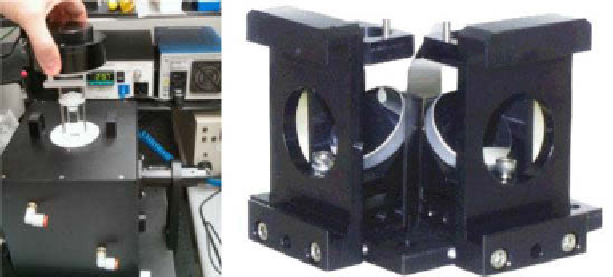Biomedical Engineering Reference
In-Depth Information
figure 6.22
External integrating sphere for quantum yield measurements with fiber-optic
bundle that fits a spectrophotometer compartment of a Nanolog, shown in figure 6.19.
nanoparticles including silica-covered nanocrystals [69], unconverted nanoparti-
cles [70], core-shell nanoparticles [56], polystyrene beads [71], and fluorescent
nanopigments [72].
6.7.2.4 Photostability
Photostability of nanoparticles can be, in principle, mea-
sured by many of the methods, but are rarely measured, often because it requires
custom equipment with uniform illumination [61] where the wavelength is selected
and the knowledge of energy is known. Most of the fluorophores are reasonably
stable
in vivo
.
6.7.3
special fluorescence techniques
6.7.3.1 Fluorescence Lifetime
In the last decade, fluorescence lifetime (flT)
became an important parameter in nanoparticle research because of its sensitivity to
the environment and because of rapid expansion in flT technique from spectroscopy
to lifetime imaging [73]. Recent availability of commercial flT imaging systems
from microscopy (Becker & Hickl gmbH (germany), ISS, Inc. (United States),
PicoQuant gmbH (germany), lambert Instruments (the Netherlands)) to small
animal imagers (advanced Research Technologies, Inc. (Canada)) has made flT not
only a spectroscopic technique but also a valuable optical modality.
flT is defined as the time required by a population of excited fluorophores to
decrease exponentially to N/2.718 (ca. 36.8% of its original number) via the loss
of energy through fluorescence and nonradiative processes. The lifetime of
commonly used fluorophores varies significantly from hundreds of picoseconds to
nanoseconds for organic compounds, tens of nanoseconds for quantum dots, and
microseconds or seconds for phosphorescence [74]. as an intrinsic property of
a fluorophore, the lifetime does not depend on the method of measurement
(time domain, frequency domain, time-gated measurements) and, in general, is
independent on initial perturbation conditions such as wavelength of excitation,
duration of light exposure, and one- or multiphoton excitation. In addition, flT is

Search WWH ::

Custom Search